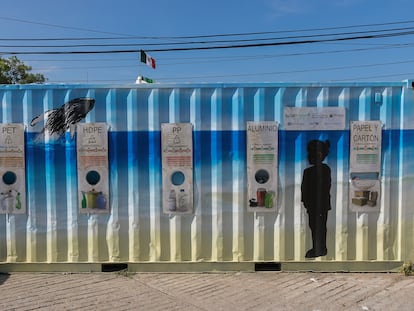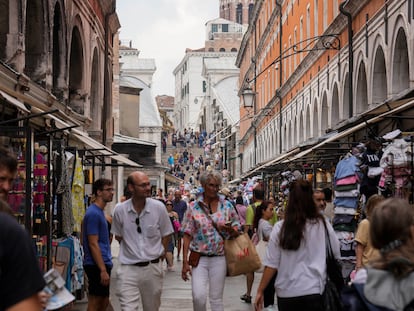Protecting the world’s most densely populated island from mass tourism
Tourism is vital for Santa Cruz del Islote, a tiny island in the Colombian Caribbean, but it also poses an existential environmental challenge

Adrián Caraballo is happy and grateful to live on the tiny, 2.5 acre-island he shares with 825 other people. “We feel this deep connection with the ocean. And even though we’re in this little place, we’ve got the vast sea around us, full of all sorts of marine life,” said the 25-year-old community and environmental leader from Santa Cruz del Islote, a tiny Caribbean island about 10 miles from the Colombian mainland. Many people say it’s the most densely populated island in the world.
Although there’s no official data, the island attracts hundreds of daily tourists, causing division among the locals and raising environmental concerns. “I don’t want us to be known for this because many tourists look down on us and think there’s poverty and overcrowding here,” said Caraballo. “But they don’t know that we’re actually rich — we have the sea! We live peacefully together. No one here has more than anyone else, and we all share whatever little we have. It’s all about island solidarity.”
“Those of us who care about the environment don’t want the island to be marketed that way. And honestly, I don’t even know who claims that we’re the most densely populated island. There are no statistics or Guinness world records to back it up — it’s all just speculation,” said Alexander Atencio, a teacher for 18 years at the island’s only school. Colombia’s Institute of Marine and Coastal Research (Invemar) acknowledged the lack of official data verifying the island as the world’s most densely populated. However, it has long been regarded as such.
Many tourists look down on us and think there’s poverty and overcrowding here. But they don’t know that we’re actually rich – we have the sea!Adrián Caraballo, resident of Santa Cruz del Islote
Santa Cruz del Islote is a part of the San Bernardo archipelago, situated within the Corales del Rosario National Park. It’s a three-hour boat ride from the renowned colonial city of Cartagena de Indias. The islands primarily depend on tourists who are drawn to the sunny and idyllic beaches. “Predatory and excessive tourism can provide short-term economic benefits for the islands, but without responsible and ecologically conscious actions, it can lead to future problems. Currently, there is an imbalance in the ecosystem due to the limited capacity of the islands,” said Atencio.

Atencio’s concern is widely shared. In 2011, the Colombian Council of State upheld a ruling by an administrative court confirming the severe environmental impact on the Rosario (27 islands) and San Bernardo (10 islands) archipelagos. Urgent protection measures were ordered, yet more than 10 years later, no action has been taken to safeguard the biodiversity of the area.
Tourism as a livelihood
Tourism is seen as a blessing by many island residents. Around 500 people come to Santa Cruz every day, mostly from major Colombian cities like Bogotá, Medellín and Cali. While there are four small hostels on the island that can accommodate approximately 20 people, visitors typically make day trips from Cartagena or Tolú, or stay overnight on the nearby islands of Tintipán and Múcura.
“Welcome to the most densely populated island in the world,” say the locals greeting the tourist boats. Visitors pay about $2.50 for a 25-minute guided tour. “The island has 146 houses built on stone, rubble, and even garbage reclaimed from the sea. A fire wiped out all the bamboo and thatch houses 74 years ago. Thankfully, no one was hurt, and the homes were rebuilt with better materials. So now we’ve got four stores, a cockfight ring, a health center, a church and a school. We don’t have any police here. We used to have one, but he just left one day and never came back,” said Gleisis Liliana Barboza, one of the 24 people in the local tour guide cooperative. At the end of the tour, people can see turtles and fish at the aquarium, and swim with a harmless nurse shark.
Tourism has replaced traditional fishing, which declined due to overexploitation and ecosystem destruction. “These days, you don’t really see folks going out to sea for fishing. The ones who still do it are mostly divers who spearfish near the shores,” said Adrián Caraballo.
Caraballo also earns a living as a tour guide, but as an environmentalist, he is worried about the growing number of visitors and the waste they leave behind. “Some tourists are environmentally conscious, others not so much. We want every visitor to take responsibility for their garbage and make a positive impact.” Waste management is one of the biggest challenges in Santa Cruz del Islote. The community is working to reduce waste impact, but recycling separation is not yet widespread.
One person collects garbage every day and later transports it to Tintipán island. Another person separates recyclables every 15 days, which are then taken by boat to Cartagena. The remaining garbage is buried in Tintipán. “I think we recover about 70% for recycling. The hotels in the archipelago do take responsibility for separating their waste,” said Omar Vanega, who works in waste management on the island.
Another issue is the sediment and garbage in the sea from other islands and coastal cities. Caraballo said they are thinking about conducting a study of the product packaging floating in the sea to engage the manufacturers in cleanup and educational efforts. “A couple of months back, we did some volunteer work where we planted mangroves and cleared out a ton of garbage from the sea.”
The islanders have made significant progress in cultivating environmentally conscious practices. “Through the Sea Turtle Foundation we started, we managed to put a stop to turtle consumption. We explained to the fishermen how crucial these creatures are for marine biodiversity and their role in safeguarding coral reefs. We even offer to swap a chicken or some grain for any turtles they find,” said Caraballo proudly.
The things tourists don’t see
There are some significant, inherent problems on this tiny island. The lack of space means limited cultural and recreational opportunities for children. Their playground is the street next to the school that serves 226 students in two shifts, some from neighboring islands. The future of the island, according to Atencio, the teacher, depends on education. The islanders are participating in an educational project that combines ethnic awareness, sustainable development and community spirit. “It’s all about having a direct connection with ecosystems, preserving culture and identity. We have a word – “maritorio” – which means viewing the sea as a whole.”
Predatory and excessive tourism can provide short-term economic benefits for the islands, but without responsible and ecologically conscious actions, it can lead to future problemsAlexander Atencio, profesor
The island’s energy comes from frequently damaged solar panels, and a generator that runs at night. For nearly a year, Santa Cruz del Islote has been without a community council, the entity responsible for liaising with government institutions. It has a health center with a permanent doctor and assistant, but they need an ambulance boat for emergencies instead of relying on the Coast Guard and private boats to take patients to the mainland. But the island’s isolation has one advantage – no Covid-19 cases were reported during the pandemic.
The island has no cemetery either. After a funeral procession through town, the deceased are taken to Tintipán. Nor does it have a potable water supply. People shower in saltwater, and every two and a half months, the Navy fills up huge water tanks on the island. A committee distributes the water evenly to the entire community. During the rainy season (November to May), people collect rainwater in their own cisterns. Sewage goes into septic tanks that empty into the sea, another environmental issue that will require significant investment. “We belong to the municipality of Cartagena de Indias, but they never visit or allocate any resources to us,” said Caraballo.
Sign up for our weekly newsletter to get more English-language news coverage from EL PAÍS USA Edition









































